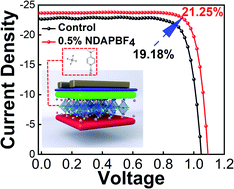Boosting the performance of MA-free inverted perovskite solar cells via multifunctional ion liquid†
Abstract
Perovskite solar cells (PSCs) with state-of-the-art efficiencies contain thermally unstable methylammonium (MA). Avoiding MA molecules usually leads to a severe decrease in the cell efficiency. In this work, a novel ion liquid (simplified as NDAPBF4) possessing a pyridine cation and BF4− anion were introduced to improve the performance of MA-free PSCs. The ion liquid NDAPBF4 can optimize the grain growth of the perovskite, leading to reduced carrier traps. In particular, NDAPBF4 served as an n-type dopant and boosted the electron transportation in the perovskite films, which further suppressed the carrier non-radiative recombination at the interface between the perovskite and the electron transporting layer. Finally, PSCs with a Cs0.05FA0.95PbI3 perovskite film as the absorber achieved a remarkable efficiency of 21.25%, which was one of the highest MA-free inverted perovskite solar cells up to date. PSCs doped with NDAPBF4 also gave excellent stability, which preserved 95% and 94% of the initial efficiency after being aged for 1000 h and 500 h under room temperature and elevated temperature at 85 °C, respectively.



 Please wait while we load your content...
Please wait while we load your content...